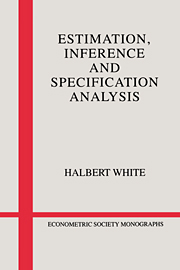
-
Select format
-
- Publisher:
- Cambridge University Press
- Publication date:
- January 2013
- September 1994
- ISBN:
- 9781139052238
- 9780521252805
- 9780521574464
- Dimensions:
- (228 x 152 mm)
- Weight & Pages:
- 0.728kg, 396 Pages
- Dimensions:
- (228 x 152 mm)
- Weight & Pages:
- 0.584kg, 396 Pages
- Series:
- Econometric Society Monographs (22)
You may already have access via personal or institutional login- Series:
- Econometric Society Monographs (22)
Book description
This book examines the consequences of misspecifications ranging from the fundamental to the nonexistent for the interpretation of likelihood-based methods of statistical estimation and interference. Professor White first explores the underlying motivation for maximum-likelihood estimation, treats the interpretation of the maximum-likelihood estimator (MLE) for misspecified probability models, and gives the conditions under which parameters of interest can be consistently estimated despite misspecification, and the consequences of misspecification, for hypothesis testing in estimating the asymptotic covariance matrix of the parameters. Although the theory presented in the book is motivated by econometric problems, its applicability is by no means restricted to economics. Subject to defined limitations, the theory applies to any scientific context in which statistical analysis is conducted using approximate models.
Reviews
‘... contains much material of interest to econometricians … a useful source book for researchers, instructors and graduate students and essential reading for those interested in the effects of misspecification.’
Source: Econometric Theory
Contents
Metrics
Altmetric attention score
Full text views
Full text views help Loading metrics...
Loading metrics...
* Views captured on Cambridge Core between #date#. This data will be updated every 24 hours.
Usage data cannot currently be displayed.
Accessibility standard: Unknown
Why this information is here
This section outlines the accessibility features of this content - including support for screen readers, full keyboard navigation and high-contrast display options. This may not be relevant for you.
Accessibility Information
Accessibility compliance for the PDF of this book is currently unknown and may be updated in the future.


